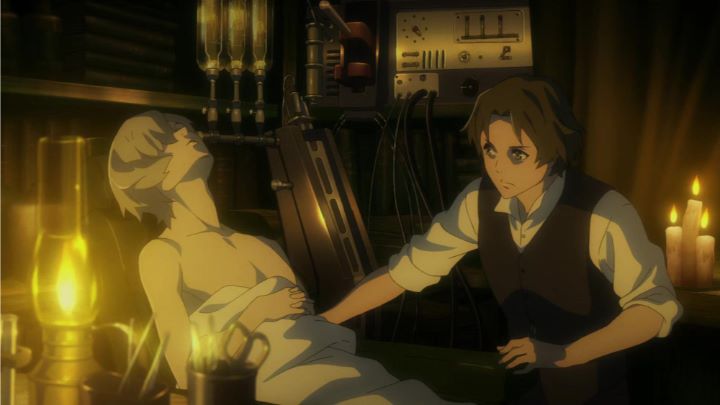








"The Empire of Corpses" is the first of an ambitious film trilogy based on the short-lived writing career of Japanese author Project Itoh. It's more fascinating to talk about the science-fiction trio as a whole, but the films are each separate self-contained stories with their own settings and characters, each with a different director and a different anime studio behind it. Of the three, "Empire of Corpses" is probably the most entertaining and easiest to get into, at the cost of the quality of its script.Unlike the other stories, "Empire of Corpses" has clearly defined inspirations, primarily the dark and ghoulish adventure novels of classic English literature. Think Mary Shelly's "Frakenstein," Bram Stoker's "Dracula," or other works by Jules Verne, H.G. Wells and Robert Louis Stevenson. So deliberate is the writing that it casually uses character names from these stories for its own inspired purposes. Young scientist John Watson works in secret on his groundbreaking and taboo research to bring a corpse back to life, using his deceased friend and partner Friday as a test subject. The use of reanimated corpses in general has become commonplace in society as a new form of cheap labor, thanks to the research of Doctor Victor Frakenstein, but these actions are unsuccessful in bringing back the original soul of the corpse (corpse workers generally don't talk or complain). Frakenstein has long since disappeared, along with his original papers. Watson is found out by the British Secret Service, and is blackmailed to work for them in lieu of being sent to prison for his illegal experiments. From there, Watson is promptly sent on an adventure, with wise-cracking Agent Burnaby alongside him, to seek out the long lost papers of Frakenstein, and ultimately to save the world from a zombie apocolypse controlled by a madman.As far as the story is concerned, there is a lot of good material here, but it gets watered down for the sake of blockbuster action. Watson's relationship with Friday is a complex one, and his goal to bring him back to life is flawed morally, but understandable. The use of taking elements from multiple works of fiction is inspired, and I haven't seen it done as well since the graphic novel series "The League of Extraordinary Gentlemen." But most of the good elements only make up a strong beginning and ending: the content of the movie is largely around globe-trotting set-pieces, where the main characters get chased by zombies, secret agents, or terrorists, speaking funny one-liners as they shoot and punch their way to safety. This isn't necessarily a bad thing, as the movie is constantly entertaining. But I kept wishing the movie would lean more into its philsophical concepts of science for the sake of it, and about going to far against sacred morals. Whenever the movie does bring up the idea, it quickly moves on to the next action scene.I could bring up the ending as a perfect example. The final scene before the credits in "The Empire of Corpses" is one of the most spine-chilling and haunting endings I could have asked for, a brilliant and thought-provoking conclusion that elevates the movie as a whole. But there is an extra clip after the credits that waters down the ending again, suggesting continuing adventures and reminding the viewer of the literary relationship that might have been missed the first time. The second clip is fun, yes, but unnecessary. This describes the film overall, being a bit unsuccessful in balancing two very different tones. For all my complaining, it is still a thought-provoking action movie, and more intelligent than most "blockbuster" movies you would see come out of Hollywood. Visually, Studio Wit (a relatively new studio, best known at the time for the stellar "Attack on Titan") does a solid job bringing the story to the big screen. The Victorian-fantasy-stylized world is well-realized and full of detail. The zombie models typically rely on 3D animation, a daring approach that only works for being applied to non-living objects and characters. Character designs are generally good, although the female action hero Hadaly is designed to have a massive chest, the one irregular and nonsensical design element that might cause distraction. The English dub tries to use appropriate accents for the characters, which can be distracting, especially when paired with some of the more cheesy lines that feel as if they came from a novel written centuries ago, but it's an impressive attempt that feels more at home than watching this particular story in Japanese. Original anime movies don't come often, and vary a lot in quality. "The Empire of Corpses" is a impressively solid action movie that is able to impress a wide audience, even if in doing so it doesn't quite nail any one given sector. The most impressive part was the writing and setting; thankfully, I have two more movies to look forward to, brought to life by the same author.
Visually, Studio Wit (a relatively new studio, best known at the time for the stellar "Attack on Titan") does a solid job bringing the story to the big screen. The Victorian-fantasy-stylized world is well-realized and full of detail. The zombie models typically rely on 3D animation, a daring approach that only works for being applied to non-living objects and characters. Character designs are generally good, although the female action hero Hadaly is designed to have a massive chest, the one irregular and nonsensical design element that might cause distraction. The English dub tries to use appropriate accents for the characters, which can be distracting, especially when paired with some of the more cheesy lines that feel as if they came from a novel written centuries ago, but it's an impressive attempt that feels more at home than watching this particular story in Japanese. Original anime movies don't come often, and vary a lot in quality. "The Empire of Corpses" is a impressively solid action movie that is able to impress a wide audience, even if in doing so it doesn't quite nail any one given sector. The most impressive part was the writing and setting; thankfully, I have two more movies to look forward to, brought to life by the same author.